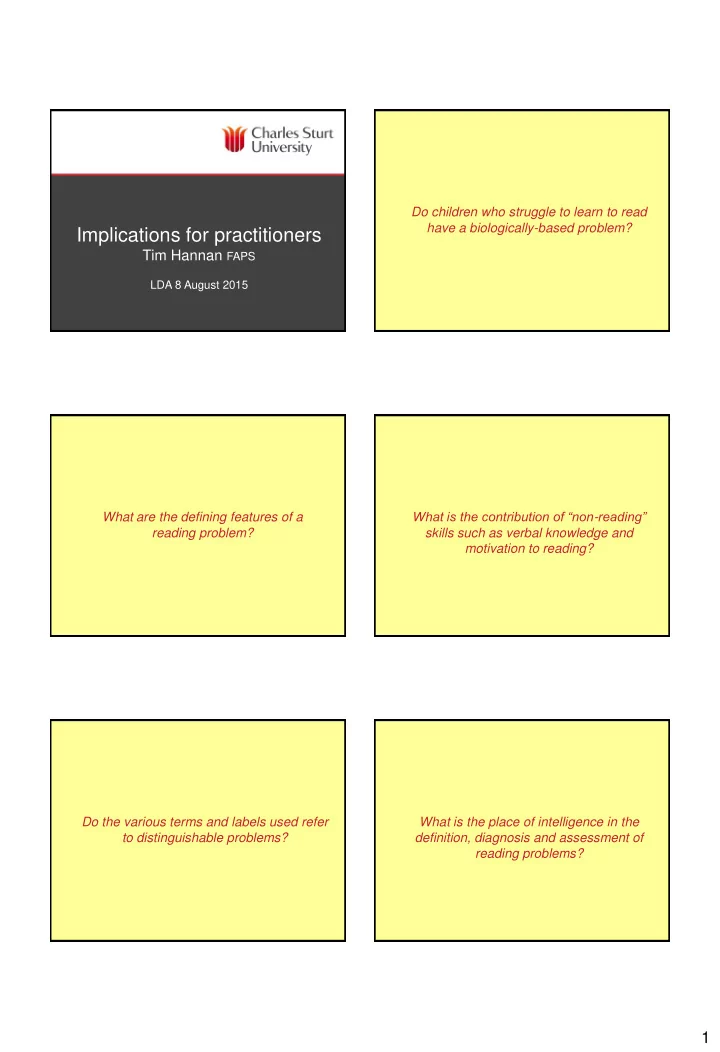

Do children who struggle to learn to read have a biologically-based problem? Implications for practitioners Tim Hannan FAPS LDA 8 August 2015 PSY523 What is the contribution of “non - reading” What are the defining features of a reading problem? skills such as verbal knowledge and motivation to reading? Do the various terms and labels used refer What is the place of intelligence in the to distinguishable problems? definition, diagnosis and assessment of reading problems? 1
What causes a reading problem? What are the core cognitive deficits which cause dyslexia? Can we diagnose dyslexia by cognitive profiles? What is the role of “response to How common are reading problems? intervention” in the diagnosis and treatment of reading problems? What interventions should be employed? Should interventions be selected on the basis of types of reading problems? How effective are they? Should interventions be tailored to an individual’s cognitive profile? 2
IQ IQ-achievement discrepancies are not a diagnostic marker or indicator of learning disorders Assessment, diagnosis IQ test profiles do not identify subtypes of RD IQ test profiles do not predict response to and classification intervention Other cognitive tests So... test score discrepancies do not identify subtypes of testing does not add to knowledge concerning the RD presence of a reading difficulty, its nature, its cause or likely prognosis measures of specific cognitive variables do not predict response to intervention task is to recognise when a child has a reading difficulty and respond to it, then examine response (RTI) But... Assessment accepting that assessment does not add to identifying a reading difficulty through observation information about reading does not lead to the (or measurement of reading alone) provides no conclusion that assessment is unnecessary and information about co-morbidity, no information uninformative about secondary consequences, no data for a full case formulation 3
Observation Questionnaires Differential diagnosis Interview Testing • reading disorder • language disorder (SLI / DLD) Formulation • intellectual disability / low intellectual abilities Diagnosis Intervention DSM-5 Neurodevelopmental Disorders Comorbidities Intellectual disability (Intellectual Developmental Disorder) • ADHD Communication disorders • Language disorder • ASD • Speech sound disorder • arithmetic disorder • Childhood-onset fluency disorder • Social (pragmatic) communication disorder • behavioural problems Autism spectrum disorder • anxiety, mood Attention deficit hyperactivity disorder Specific learning disorder Motor disorders • Developmental coordination disorder • Sterotypic movement disorder • Tic disorders Two hats clinical administrative Aims of assessment 4
reading reading disorder disorder reading abilities reading abilities 5% ile 70 85 100 115 130 70 85 100 115 130 intelligence grammar 130 130 reading specific disorder phonological deficit (probable 115 115 reading disorder) reading abilities phonology 5% ile 10% ile 70 85 115 130 70 85 115 130 85 85 10% ile 10% ile low intellectual abilities language disorder language disorder (poor comprehender) 70 70 intellectual disability Interventions 5
“Scientific evidence does not support the claims that visual training, muscle exercises, ocular pursuit-and-tracking exercises, behavioral / perceptual vision therapy, “training” glasses, prisms, and colored lenses and filters are effective direct or indirect treatments for learning disabilities. There is no valid evidence that children who participate in vision therapy are more responsive to educational instruction than children who do not participate.” A Joint Statement of the American Academy of Pediatrics, American Association for Pediatric Ophthalmology and Strabismus, and American Academy of Ophthalmology (2012) “Multisensory learning involves the use of visual, auditory, and kinesthetic-tactile pathways simultaneously to enhance memory and learning of written language. Links are consistently made between the visual (language we see), auditory (language we hear), and kinesthetic-tactile (language symbols we feel) pathways in learning to read and spell.” IMLE (accessed May 2015) Samuel Orton “The [Australian Dyslexia Association] supports and provides accredited training in evidence based instruction with the addition of a multisensory component. Direct, explicit and structured instruction with a multisensory component can assist all students including those with dyslexia and related difficulties.” dyslexiaassociation.org.au (retrieved 7 August 2015) 6
At last the Dodo said, “Dyslexia”? “everybody has won, and all must have prizes”. Carroll (1865) “The era of applying the label “dyslexic” is rapidly “The term “dyslexia” is so rooted in everyday drawing to a close. The label has served its discourse that, for some, the articulation of function in drawing attention to children who theoretical and ethical concerns about its use can do little to reduce its hold” have great difficulty in mastering the arts of reading, writing and spelling but its continued use invokes emotions which often prevent Elliott & Grigorenko (2014), p.182 rational discussion and scientific investigation” Yule (1976) Directions ruthless commitment to empirically-supported theories and procedures articulation of best practice guidelines for practitioners education, training and professional development thorough response to pseudoscientific methods 7
Recommend
More recommend